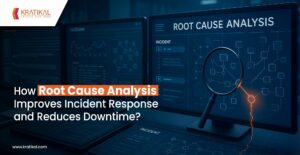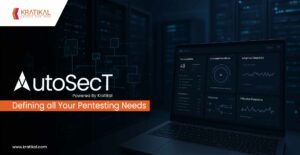Privileges refer to the permissions granted to a user or group of systems, allowing them to perform specific tasks. A user with such privileges can carry out security-sensitive operations within a system. To gain full control over a network, attackers often attempt privilege escalation—an intrusion technique where they exploit coding flaws or improper handling to elevate their access. This enables them to access critical data, applications, and broader parts of the network.
Privilege escalation is of two kinds:
- Vertical privilege escalation: In this level of escalation, the attacker escalates his privilege to a user’s with higher privileges.
- Horizontal privilege escalation: At this level, the attacker assumes the identity of a user who has the same privileges as him.
Table of Contents
How Does an Attacker Escalate Privileges?
If the attacker knows about the vulnerability in code flow of the running service or program, then, they can escalate their privileges. Attackers use various methods including Powershell, Executable binaries, Metasploit modules etc for escalating the privileges.
Hackers can maintain access to all the services and make them more vulnerable to exploitation. In case the services are not maintained properly and if the permissions are word-writable, then, anyone can write their scripts for execution purposes. This could result in huge damage such as capturing your confidential data or changing the flow of the data.
Types of Privilege Escalation Attacks
Now that you have a clearer understanding of privilege escalation attacks, let’s take a look at five examples, including:
Windows Sticky Keys
When targeting Windows for a privilege escalation attack, I often begin with the “sticky keys” exploit. It’s a relatively simple technique that doesn’t demand advanced skills to execute.
To carry out this attack, you’ll need physical access to the machine and the ability to boot from a repair disk. Once you’re in, the goal is to replace the system file linked to the sticky keys function (triggered by pressing the Shift key five times).
Using the command prompt, start by making a backup of the <sethc.exe> file located in %systemroot%\system32. Then, copy <cmd.exe> to the same directory and rename it to <sethc.exe>. Once the command prompt executable is placed correctly, reboot the system. At the login screen, press the Shift key five times to trigger the “sticky keys” feature — but instead, it will now launch a command prompt with SYSTEM-level access. With this elevated access, an attacker can easily create a local administrator account, effectively setting up a backdoor into the system.
Process Injection
Exploiting weak processes is another technique I often use for privilege escalation. A commonly used tool in penetration testing for this purpose is Process Injector. This tool can list all active processes on a system and identify the user account each process is running under, making it easier to spot potential privilege escalation opportunities.
To carry out this attack, you’ll need access to an account with elevated privileges. Once you’ve identified the target process—such as cmd.exe—you can execute a command like:
pinjector.exe –p <PID of the process with the desired permissions> cmd.exe <port>. This allows you to inject into the chosen process and operate with its permission level.
Linux Password User Enumeration
A common and straightforward privilege escalation technique on Linux involves enumerating user accounts on the system. To perform this attack, the attacker needs shell access—often gained through vulnerabilities like misconfigured FTP servers.
After gaining shell access, an attacker can list all user accounts on the system by running the command: cat /etc/passwd | cut -d: -f1. This command extracts the usernames from the /etc/passwd file.
What are the different ways in which attackers escalate privileges?
Dumping Security Account Manager files (For Windows)
One of the most commonly adopted methods to escalate privileges is to dump Security Account Manager files. Security Account Manager or SAM files contain encrypted passwords. The attacker steals password hashes from these files and easily accesses the system.
Shared folders are infamously exploited because these folders usually contain sensitive information. These folders have either a few restrictions or sometimes none.
Buffer Overflow
Attackers can exploit vulnerabilities such as buffer overlow that might be exploited for executing arbitrary code with privileges elevated to the Local System. If errors are not handled correctly, system service that is impersonating the lesser privilege user, can elevate that user’s privileges.
Cross Zone Scripting
This is a type of privilege escalation attack where a website destabilizes the security model of web browsers, thus, letting the malicious code run on client computers.
How Can we Prevent Privilege Escalation?
According to experts following mitigation techniques can help in preventing the escalation of privileges:
- Network Administrators must check the program or service permissions correctly. Issues must be resolved as soon as possible so that there is no misconfiguration.
- Use docker containers or virtual machines for remote services such as login to the client user, for mitigation or to decrease the misconfiguration detection as well as the exploitation of services by the attacker.
- Assess machines that switch permissions or might cause any other harm.
- Avoid the use of multiple scripts for different purposes since this can make it difficult to check the proper permissions of the script running.
- While these mitigation techniques are effective, it is important to inculcate the practice of regular vulnerability assessment and penetration testing. Pen testers invade the network, device or an application to achieve privilege escalation. In case of a successful attempt, testers will work on patching up the entry points that might lead to privilege escalation.
Conclusion
Privilege escalation attacks pose significant threats to organizations, enabling unauthorized access to sensitive data and critical systems. Attackers exploit coding flaws, misconfigurations, and weak security practices to elevate their permissions and gain control over networks. Implementing strong preventive measures, such as proper permission management, security monitoring, and the use of containerized environments, can help mitigate these risks. However, regular vulnerability assessment and penetration testing (VAPT) remain essential in identifying and remediating security gaps before attackers can exploit them. By proactively securing systems and continuously evaluating potential attack vectors, organizations can strengthen their defenses and ensure robust cybersecurity resilience.
FAQs
- In which attack phase is privilege escalation performed?
Privilege Escalation (PrivEsc) occurs during the Gaining and Maintaining Access phase, enabling attackers to elevate their privileges within IT infrastructure.
- Is privilege escalation a passive attack?
Privilege Escalation is not an attacker’s main objective, but it plays a crucial role in the attack chain. It allows them to transform initial access into elevated privileges, gaining control over SYSTEM, root, administrative, or other user accounts with critical system permissions.









Leave a comment
Your email address will not be published. Required fields are marked *